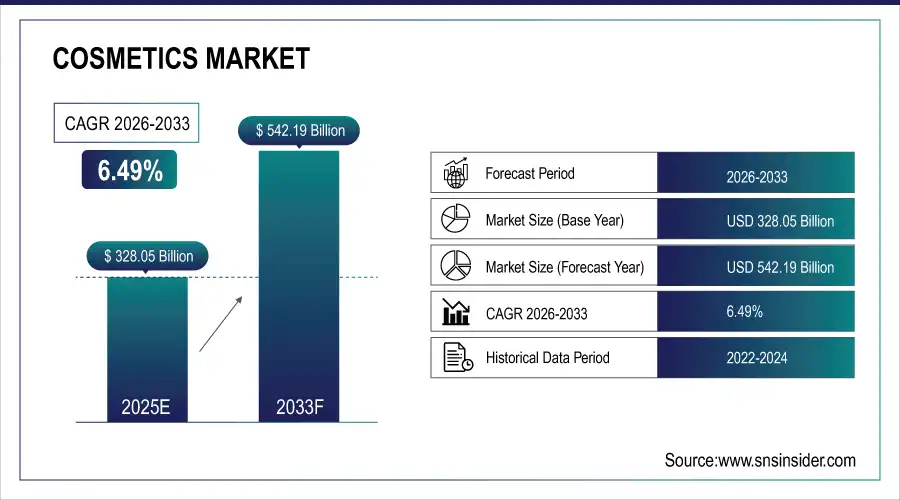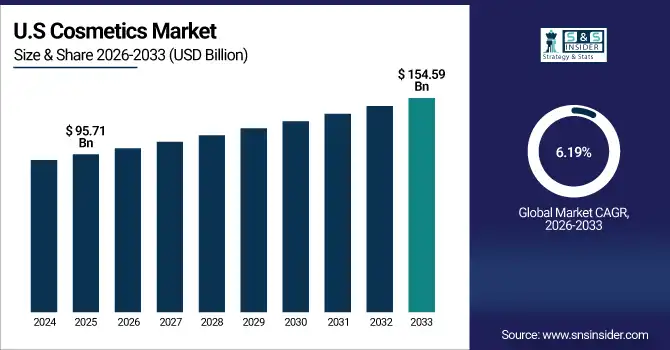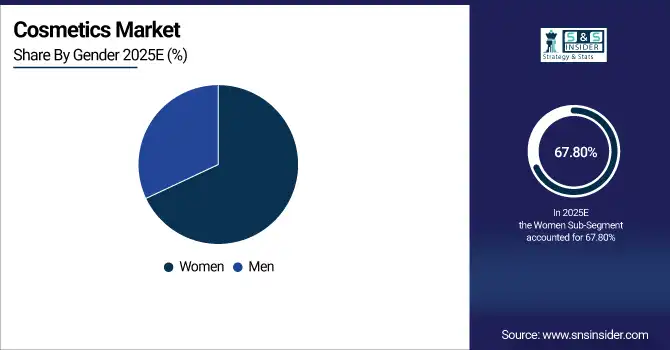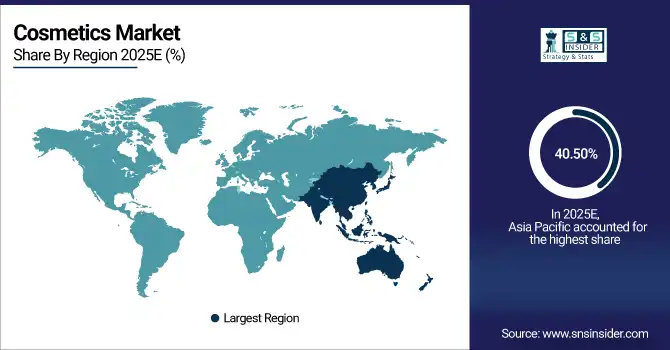Cosmetics Market Report Scope & Overview:
The Cosmetics Market Size was valued at USD 328.05 Billion in 2025E and is expected to reach USD 542.19 Billion by 2033 and grow at a CAGR of 6.49% over the forecast period 2026-2033.
The Cosmetics Market analysis, driven by high consumer consciousness and awareness on personal appearance, cosmetics and beauty aspects, increasing consumer incomes coupled with changing lifestyle. Rising demand for natural and organic products from health and environmentally-conscious consumers is also driving growth. According to analysis, approximately 68% of global consumers now actively follow skincare and beauty routines, reflecting growing personal grooming awareness.
Market Size and Forecast:
-
Market Size in 2025: USD 328.05 Billion
-
Market Size by 2033: USD 542.19 Billion
-
CAGR: 6.49% from 2026 to 2033
-
Base Year: 2025
-
Forecast Period: 2026–2033
-
Historical Data: 2022–2024

To Get more information On Cosmetics Market - Request Free Sample Report
Cosmetics Market Trends
-
Rising consumer awareness boosts demand for skincare, haircare, and beauty products globally.
-
Social media influence drives purchasing decisions through beauty influencers and digital campaigns.
-
Increasing disposable incomes enable higher spending on premium and innovative cosmetic products.
-
Growing preference for natural and organic cosmetics fuels eco-friendly product launches.
-
Male grooming segment expands rapidly due to rising awareness and lifestyle changes.
-
Sustainable and cruelty-free formulations create opportunities for differentiation and brand loyalty.
The U.S. Cosmetics Market size was USD 95.71 Billion in 2025E and is expected to reach USD 154.59 Billion by 2033, growing at a CAGR of 6.19% over the forecast period of 2026-2033, driven by high consumer awareness, strong demand for premium and natural products, influencer-driven marketing, e-commerce expansion, and increasing adoption of skincare, makeup, and male grooming solutions, making it a highly lucrative and competitive region.

Cosmetics Market Growth Drivers:
-
Rising Consumer Awareness and Grooming Trends Fuel Cosmetics Market Growth Rapidly
The Cosmetics Market growth, due to growing focusing of consumers towards personal grooming. Customers are also more knowledgeable regarding skin-care regimens, anti-aging treatments and specialised haircare regimens. Social media, beauty influencers and digital campaigns have had a major impact on buying behaviour, educating consumers about what actually works and new trends. Furthermore, burgeoning disposable incomes particularly in emerging countries such as India, China and Brazil enable consumers to spend more on premium-quality organic cosmetic products with advanced technology. It’s this mix of awareness, value and online influence that helps fuel steady market expansion.
Specialized haircare products, such as serums and treatments, represent ~18% of the global haircare segment in 2025.
Cosmetics Market Restraints:
-
Stringent Regulations and Safety Concerns Challenge Cosmetics Industry Expansion Globally
The major factor behind the cosmetics market growth, driven by The Increase in consciousness related to personal grooming, caring skin and overall appearance. Today’s consumers are better educated on the advantages of skincare regiments, anti-aging products and premium hair care treatments. Social media, beauty influencers and digital campaigns have driven purchase behavior informing consumers on product efficacy and trends. Furthermore, increasing disposable incomes, particularly in developing economies such as China, India and Brazil, give people more to spend on premium, organic and high-tech cosmetic goods. This intersection of consciousness, accessibility and digital reach continues to drive steady market expansion.
Cosmetics Market Opportunities:
-
Growing Demand for Natural Organic Cosmetics Creates Lucrative Market Potential
The increasing demand of health and eco-friendly conscious consumers represents a huge potential in the sector of natural and organic cosmetics. Plant-based products, cruelty-free designs and sustainable packaging are increasingly demanded around the world. There is a strong market for products that are environmentally friendly, chemical-free and ethically made. There is a strong demand for clean beauty products in North America, Europe and Asia-Pacific and is creating avenues for brands to add more product lines, R&D of natural formulations and can gain niche market. This change represents income opportunity and brand separation in a crowded market.
Sustainable Packaging: About 30% of products in this segment use recyclable, biodegradable, or refillable packaging.
Cosmetics Market Segmentation Analysis:
-
By Category, In 2025, Skincare led the market with a share of 42.50%, while Haircare is the fastest-growing segment with a CAGR of 7.45%.
-
By Ingredient Type, In 2025, Synthetic led the market with a share of 52.60%, while Natural/Organic is the fastest-growing segment with a CAGR of 7.90%.
-
By Gender, In 2025, Women led the market with a share of 67.80%, while Men is the fastest-growing segment with a CAGR of 7.35%.
-
By Distribution Channel, In 2025, Supermarket led the market with a share of 36.50%, while Online Channels is the fastest-growing segment with a CAGR of 8.10%.
By Category, Skincare Lead Market and Haircare Fastest Growth
Skincare is the leading segment of cosmetics market in 2025, led by increasing demand for anti-aging products and awareness about personal grooming among consumers. Social media, beauty vloggers, and digital campaigns have also continued to drive demand, especially in the urban areas of North America, Europe and Asia-Pacific. Meanwhile, Haircare segment is the fastest growing due to rising adoption of serums treatments and premium hair products. Rising consumer disposable incomes, demand for natural ingredients and advancement in hair care formulations are driving its rapid growth and market potential.
By Ingredient Type, Synthetic Lead Market and Natural/Organic Fastest Growth
The Synthetic segment is dominating the cosmetics market in 2025, due to its mass production, low cost and availability across almost all skin care/hair care/make up products segments. Even successful brands continue to use synthetic formulas in order for the product to stay on the shelf. Meanwhile, Natural and Organic is the fastest growing segment fuelled by increasing demand for eco-friendly, free of chemicals, and non-abusive products consumers. Its rapid growth in the North America, Europe, and Asia-Pacific is due to growing popularity of healthy options, sustainable packaging and increasing preference for premium-priced products.
By Gender, Women Lead Market and Men Fastest Growth
The Women’s segment dominates the cosmetics market in 2025, by covering the most demand in skincare, makeup and haircare. Strong usage of products, brand loyalty and the power of social media campaigns help this category to dominate market share especially in urban and developed areas. Meanwhile, Male is the fastest segment supported by a growing importance of personal grooming awareness and more disposable income and growing sales in men specific skincare, haircare and premium products in developing markets and mature markets.

By Distribution Channel, Supermarket Lead Market and Online Channels Fastest Growth
The Supermarket is the leading segment of cosmetics market in 2025, driven by with products available across skincare, haircare, and makeup segments; being accessible to consumers owing to their competitive price point. A strong foothold among urban and semi-urban markets, promotional activities and branding collaborations continue to cement its leadership. Meanwhile, Online Channels is also projected to grow at a highest CAGR with growth in e-commerce, influencer marketing and digital campaigns. Home deliveries, customized recommendations and subscriptions are driving the rapid expansion of online cosmetic sales around the world as consumers make fewer pilgrimages to bricks-and-mortar stores.
Cosmetics Market Regional Analysis:
Asia Pacific Cosmetics Market Insights:
The Asia Pacific dominated the Cosmetics Market in 2025E, with over 40.50% revenue share, driven by growing consumers' awareness, higher disposables incomes and significant urbanization Health-conscious and beauty-obsessed consumers are driving high demand in skincare, haircare and makeup. Increasing demand for natural and organic cosmetics, coupled with the high penetration of e-commerce and availability of influencer marketing accelerates market growth. The growing popularity of luxury and unique products continues to support Asia-Pacific’s status as the largest and most exciting regional cosmetics market.

Get Customized Report as per Your Business Requirement - Enquiry Now
China and India in Cosmetics Market Insights
China and India lead the cosmetics market due to rapidly growing urban populations, increasing disposable incomes, rising beauty consciousness, and strong demand for skincare, haircare, and premium personal care products, coupled with expanding e-commerce and digital marketing adoption.
North America Cosmetics Market Insights:
The North America region is expected to have the fastest-growing CAGR 7.62%, due to high levels of consumer awareness, sophisticated retail distribution networks, and high disposable incomes. Skincare, makeup and premium personal care products are fueling demand with more consumers desiring natural, organic and environmentally-friendly options. When added to digital marketing, influence of social media and adoption of e-commerce is a shortcut to product accessibility alongside brand engagement. Increasing product innovation, personalized beauty and care solutions, and the rise in male grooming trends are driving market growth.
U.S. and Canada Cosmetics Market Insights
The U.S. and Canada are growing in the cosmetics market due to high consumer awareness, preference for premium and natural products, strong e-commerce adoption, influencer-driven marketing, and increasing demand for personalized skincare, haircare, and male grooming solutions.
Europe Cosmetics Market Insights
Europe Cosmetics Market is expected to witness increased demand by high consumer awareness, demand for premium of the product offerings, sustainable and ethical beauty. Skincare, hair-care and make-up are key, with demand for skincare products trending toward natural, organic and eco-friendly. The growth of e-commerce, digital marketing and influencer campaigns also democratize product access and consumer interaction. The persistence of extensive innovation and sophisticated formulation, and increasing male grooming habits all play a role in the continued widening of market scope. Europe will remain an important mature region within the global cosmetics space.
Germany and U.K. Cosmetics Market Insights
Germany and the U.K. are growing in the cosmetics market due to strong demand for premium and organic products, high consumer awareness, sustainability focus, advanced retail infrastructure, digital marketing influence, and increasing adoption of innovative skincare, haircare, and makeup solutions.
Latin America (LATAM) and Middle East & Africa (MEA) Cosmetics Market Insights
The Latin America (LATAM) and Middle East & Africa (MEA) regions are witnessing gradual growth in the Cosmetics Market, driven by increasing disposable income, changing beauty trends and expanding young population. Growing urbanization and rising influence of social media will drive adoption for skin, hair care and makeup products. Consumers in these two regions are increasingly interested in value-for-money cosmetics and natural and organic formulations. Growing availability of retail networks, e-commerce and the saturating lower the brand name across space is further driving market growth making LATAM and MEA as potential future markets in global cosmetics industry.
Cosmetics Market Competitive Landscape
L’Oréal leads the global cosmetics market through extensive product innovation across skincare, haircare, and makeup segments. The company’s focus on R&D, digital marketing, and e-commerce expansion has strengthened brand presence worldwide. With growing consumer demand for natural, premium, and personalized products, L’Oréal continues to capture market share, driving growth in both developed and emerging regions while maintaining leadership in sustainability and cruelty-free initiatives.
-
In June 2025, L’Oréal announced a strategic partnership with NVIDIA to enhance its artificial intelligence capabilities. This collaboration aims to supercharge AI-driven beauty experiences, including personalized skincare recommendations and virtual try-ons.
Johnson & Johnson leverages its strong healthcare and consumer products expertise to maintain a significant footprint in the cosmetics market. Its focus on skincare and baby care products, combined with growing awareness of safe and dermatologically tested formulations, supports steady growth. The company invests in digital engagement and innovative product offerings, addressing consumer demand for natural, ethical, and effective personal care solutions globally.
-
In August 2025, Johnson & Johnson introduced the Baby Skin Nourish line, featuring hypoallergenic products free of parabens, phthalates, and dyes. The line was designed to gently cleanse and moisturize, leaving baby's skin soft and smooth.
Revlon maintains a strong presence in makeup, skincare, and haircare markets through iconic brands and mass-market appeal. Despite challenges, the company focuses on product innovation, digital campaigns, and influencer marketing to attract younger consumers. Expansion in emerging markets, coupled with growing demand for affordable premium products, enables Revlon to sustain growth and enhance its competitive position within the global cosmetics industry.
-
In May 2025, Revlon announced a collaboration with Palm Angels to develop fragrance lines for both men and women, with a debut collection slated for a 2027 launch. This partnership aims to expand Revlon's presence in the luxury lifestyle sector beyond fashion.
Cosmetics Market Key Players:
Some of the Cosmetics Market Companies are:
-
L’Oréal S.A.
-
Estée Lauder Companies Inc.
-
Procter & Gamble (P&G)
-
Unilever plc
-
Shiseido Company Ltd.
-
Beiersdorf AG
-
Coty Inc.
-
Johnson & Johnson
-
Natura &Co
-
Henkel AG & Co. KGaA
-
Kao Corporation
-
Amway Corporation
-
Avon Products Inc.
-
Mary Kay Inc.
-
LVMH (Moët Hennessy Louis Vuitton)
-
Chanel Ltd.
-
Yves Rocher / Groupe Rocher
-
L’Occitane Group
-
Revlon Inc.
-
Oriflame Cosmetics AG
| Report Attributes | Details |
|---|---|
| Market Size in 2025E | USD 328.05 Billion |
| Market Size by 2033 | USD 542.19 Billion |
| CAGR | CAGR of 6.49% From 2026 to 2033 |
| Base Year | 2025E |
| Forecast Period | 2026-2033 |
| Historical Data | 2022-2024 |
| Report Scope & Coverage | Market Size, Segments Analysis, Competitive Landscape, Regional Analysis, DROC & SWOT Analysis, Forecast Outlook |
| Key Segments | • By Category (Haircare, Skincare, Makeup, Others) • By Ingredient Type (Natural/Organic, Synthetic, Hybrid) • By Gender (Men, Women) • By Distribution Channel (Specialty Stores, Supermarket, Online Channels, Others) |
| Regional Analysis/Coverage | North America (US, Canada), Europe (Germany, UK, France, Italy, Spain, Russia, Poland, Rest of Europe), Asia Pacific (China, India, Japan, South Korea, Australia, ASEAN Countries, Rest of Asia Pacific), Middle East & Africa (UAE, Saudi Arabia, Qatar, South Africa, Rest of Middle East & Africa), Latin America (Brazil, Argentina, Mexico, Colombia, Rest of Latin America). |
| Company Profiles | L’Oréal S.A., Estée Lauder Companies Inc., Procter & Gamble (P&G), Unilever plc, Shiseido Company Ltd., Beiersdorf AG, Coty Inc., Johnson & Johnson, Natura &Co, Henkel AG & Co. KGaA, Kao Corporation, Amway Corporation, Avon Products Inc., Mary Kay Inc., LVMH (Moët Hennessy Louis Vuitton), Chanel Ltd., Yves Rocher / Groupe Rocher, L’Occitane Group, Revlon Inc., Oriflame Cosmetics AG, and Others. |

